Proton Saga SV 1.3 CVT Test Drive Review
The national car project was kick-started in the 1980s with the stated intention of spurring our country’s drive towards industrialization and also to provide the people with affordable motorized transport. Nearly 30 years on, with debates raging over the newly introduced Accord-based Proton Perdana, the success and merits of that initiative remains open to debate.
What’s not open to debate, however, is how car prices have crept up at a rate that is outstripping the average salary increase of the common public. Cars are becoming less affordable and people are being saddled with nine-year loans just to pay off an entry-level Toyota Vios. Common grouses amongst Malaysians on social media and public forums revolve around car prices and how the people are being deprived of affordable choices from imported brands.
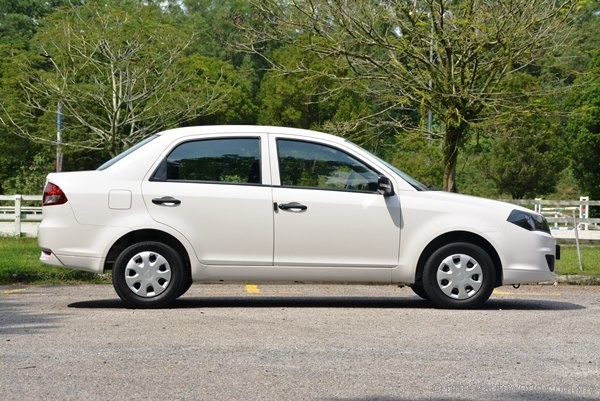 |
| 13-inch steel wheels and black door handles betray the SV’s entry price point. |
In the meantime, Proton, the national car originally tasked, on paper at least, to provide the people with affordable cars, has been trying to move their products upmarket as well, and that means they are no longer producing just cheap cars, even if their cars are on average cheaper than the rest. Products like the Preve and Suprima demonstrate aspirations to rise up the industry food chain, but where does that leave those of us who are operating on shoestring budgets but would nevertheless like a half-decent mode of set of wheels?
Earlier this year, Proton went back to its roots and launched the Saga SV which offers affordability as its key-selling point. The SV suffix to its name stands for ‘Super Value’ and to underline that point, Proton has priced it lower than existing variants of the Saga without removing any safety-related equipment.
 |
Prices and Variants
For as low as RM33,426, you can have a Saga SV parked on your driveway. An additional RM450 buys you metallic paint, and a premium of RM3,000 helps you swap out the standard 5-speed manual transmission from Getrag with a CVT. As such, our solid white CVT test car pictured here hits the road at RM36,426, which at a Perodua showroom gets you only a Viva, and not even the top-spec model at that.
Standard equipment covers the basics and little else; you do get central locking, remote-operated alarm, immobilizer, reverse sensor, a single DIN radio from Clarion, blinkers on the side mirror, and crucially, dual airbags. Interestingly, Proton continues to offer the Saga FLX 1.3 Standard at a premium of around RM4,700 adding only tinted windows and a trunk-lid cover. Other options in the range include the better-specced 1.3 Executive manual and CVT variants at RM42k – RM45k and the range-topping 1.6 SE CVT at RM49k.
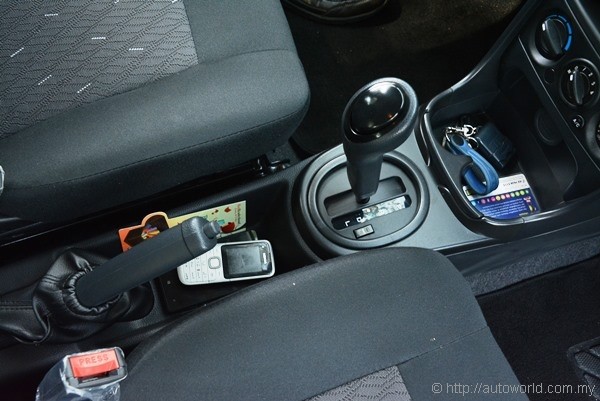 |
| No complaints on centre console storage spaces. |
Specifications
Mechanically, the Saga SV is identical to existing variants of the 1.3 FLX, being powered by the same 1,332cc Campro IAFM engine churning out 94hp and 120Nm. All other running gear, and this includes brakes, suspension, and steering, remain unaltered as well.
Structurally however, Proton implemented a number of safety-related improvements for all variants of the Saga in 2013, making dual airbags as standard and adding a three-point seat belt for the centre rear passenger. The entire vehicle structure has been strengthened, most noticeable enforcements being a new set of bracings strengthening the area separating the passenger compartment from the boot.
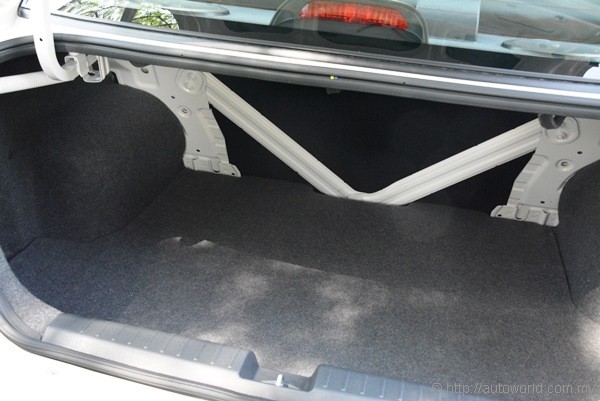 |
| V-shaped bracing is a new addition to reinforce the 2013 Saga’s structure. |
Exterior
The SV’s austere appearance is largely identical to the FLX Standard sitting one rung up featuring covered 13-inch steel rims at the corners, unpainted side mirrors and door handles, and black plastic covering slots on the bumper that would otherwise be occupied by a pair of fog lights in higher-spec models.
Distinguishing it from the FLX Standard is the ‘SV’ badge marker on the boot lid and the unpainted plastic garnish above the number plate. Decorative finishing on the tail pipe has also been dispensed with. Appearance-wise, the SV makes no effort to hide its entry-level disposition; it is a difficult car to fault for honesty to be sure.
 |
Interior
The Saga SV’s interior layout largely retains the original architecture as introduced in the 2008 Saga BLM, though a number of running changes are introduced. All-round power windows are now standard as is (thankfully) dual airbags, and three-point rear centre passenger seat belt. The latter was quite obviously an afterthought, a point made quite clear by the bulky plastic casing which encloses its top mounting on the rear parcel; no issue however, better late than never.
Seat cushions feel significantly firmer than before, offering improved support, but inadvertently raising the hip point to a level that makes clear visibility of the instrument cluster impossible for this 170cm tester. As reference, I perched myself inside a unit of the original BLM and found no such visibility issues. Still on the topic of visibility, the new side mirrors with integrated turn signals introduced with the 2010 Saga FL also seemed to offer a narrower field of vision compared to the bigger mirrors fitted in the BLM; and by the way, side mirror adjustment is manual, as in wind-down-the-window-and-push-the-mirror-with-your-fingers manual.
 |
| Side mirror adjustment is manual. You stretch and reach your hands out. |
These two visibility niggles aside, little else is wrong with the Saga’s ergonomics, though a car of such simplicity should not be difficult to get right to start with. The unassuming centre console is well moulded to accommodate a generous volume of small item storage, whilst controls are placed with easy reach and painless to operate. The Clarion head unit’s control scheme could use some fine-tuning, however. Our test car’s automatic tuner was only able to latch on to a paltry two radio stations across the entire FM spectrum and compounding the issue was the less than straight forward access to its manual tuning function. I won’t waste words to elaborate on that here, but suffice to say I needed to read the manual on that one.
Contrary to popular opinion about Proton’s build quality, our test car’s interior was solidly put together, with the infamous rattles commonly associated with the brand notable for their absence. Material choices are unsurprisingly coarse and not exactly plush, but you really can’t be expecting stitched leather if you’re getting change out of RM40k. The various panels in our test car felt pleasingly solid and aligned with decently consistent gaps. Noise insulation was not too bad either; it’s definitely better than my Waja’s, to start with.
 |
| Driving position is poorly calibrated. There was no way to get full visibility of the instruments. |
Driving Experience
The Saga SV’s driving characteristics follow the typical template laid down by Proton cars in recent years – excellent dynamics married with average powertrains. Ride and handling is, as usual with modern Protons, well-sorted and impressively sophisticated, almost European in feel. It may not have the measure of the Ford Fiesta or Suzuki Swift, but you can definitely carry more speed into a corner than you would in say, a Perodua Myvi.
Having said that, the SV also lacks the Myvi’s overall ease-of-use which distinguishes Perodua’s top-seller as an excellent urban runabout. The steering, in particular, may be a spot of bother to some, feeling rather heavy and cumbersome to twirl in tight spaces. As enthusiasts however, we appreciate the stability afforded by its extra weight when charging into high-speed corners.
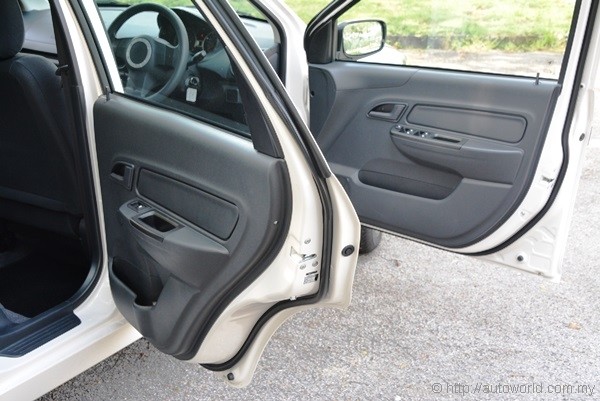 |
| Door cards have some texture, but the entire piece is hard plastic. |
Compared to the 2008 BLM model, the 2013 car we tested here also benefits from a stiffer set up, which imposes slight penalties on ride comfort, but results in a flatter stance around corners. The firmer ride in comparison to the older car is obvious, which is a surprise because we are basing our observations against a M-Line BLM which has 185/60 R14 tyres as opposed to our test car’s higher-profile 175/70 R13 donuts.
Composure at high speeds is impressive; we sustained cruising speeds of 140kph with minimal fuss, although getting there requires choosing between expediency and refinement – you either let the Campro-CVT combo gradually gather speed at half throttle or brace yourself for the simultaneous aural assault of the CVT whine and the engine’s high-revving scream when you slam the throttle. Most of the time, we found the gentle approach preferable.
It really is no exaggeration to say that the Punch CVT currently in use by Proton isn’t the best transmission of its kind in the market. Overall refinement levels remain some way short of market benchmarks and the novelty of adding a 6-speed stepped automatic transmission mode seem like an unnecessary exercise for all the difference it made to the driving experience, which is none. One aspect in which the transmission redeems itself is its well-honed gradient logic that offers useful amounts of engine braking whilst descending slopes, even with the selector at ‘D’. It is a characteristic that nicely complements the vehicle’s sound suspension dynamics allowing for confident downhill runs.
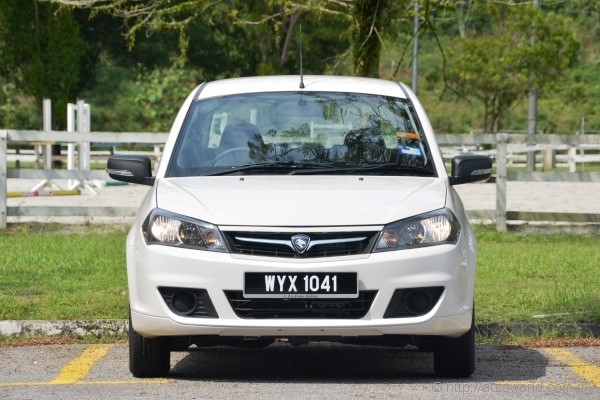 |
| No foglights and side mirrors are black, but with integrated turn signals. |
Verdict
Affordable without compromising on safety, the Saga SV is a praiseworthy product from Proton. It’s philosophy of offering on par safety specifications with models at the top of the range is something that sits well with us – luxuries and amenities can be made optional, but safety should always be standard across the board. Further improvements are still possible, but the SV’s safety spec is on par with the version that earned the Saga its three-star ASEAN NCAP rating.
The Saga SV is a product built on a simple yet highly effective formula, which is to offer a decently-sized three-box sedan at an affordable price. Its well-honed driving dynamics adds an unexpected layer of enjoyment to the package, although amateur design errors such as the over-elevated seating position should really not have been allowed to even leave the drawing board, much less make it to production.
Uncomplicated and unpretentious, the Saga SV is a sensible choice for buyers at a budget looking for a fuss-free mode of transport. It is one of those put-petrol-and-go type vehicles, making it especially worth considering for first time buyers cutting their teeth out in the open road before finally upgrading to something a little bit more powerful or desirable.
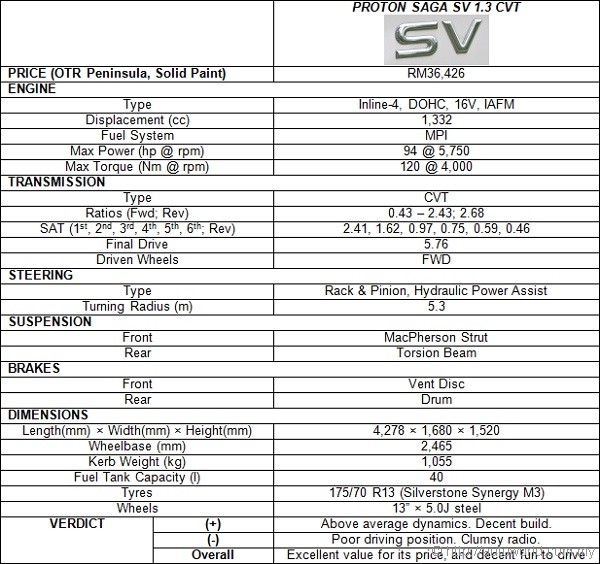 |























